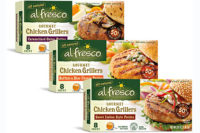Kayem Foods Inc., Chelsea, Mass., is the largest meat processor in New England. More than 100 years ago, founder Kazimierz Monkiewicz (K.M. = “Kayem”) built a reputation for high-quality meats, and today, Kayem produces more than 100 varieties of hot dogs and 300 varieties of deli meats, sausage and dinner hams to stringent quality standards, and ships nationally. Maintaining high product quality is a priority as demand grows — and that means paying close attention to freezing processes.
In early 2011, Linde North America installed a cryogenic tunnel freezer at Kayem’s fresh sausage plant in Woburn, Mass., but expanding distribution quickly pushed the freezer to capacity. Kayem’s Matt O’Malley, vice-president of manufacturing at the plant explains: “Al fresco chicken links had really taken off faster than expected, and the successful launch of al fresco chicken burgers required even more line time on that tunnel.”
Kayem reviewed its options in 2012, and decided to upgrade to a patented Linde impingement freezer, which provides the highest freezing capacity per square foot in the industry combined with the lowest operating cost of cryogenic freezers. In early 2013, Linde installed the new freezer in less than a week, and essentially doubled the line’s freezing capacity in about the same space.
With the new freezer, the surface of the sausage is instantly crust-frozen with a liquid nitrogen spray and high-velocity nitrogen gas, trapping moisture inside the product. As the sausage continues along the belt, it continues to be impinged from all sides with high-velocity nitrogen gas. This impingement freezing technology, patented by Linde, maximizes both production throughput and process efficiency.
Once it exits the Linde impingement freezer, product is trayed, overwrapped, metal-detected, labeled and put into a master case for final freezing — all in about 90 seconds. On the input side, a patty machine feeds the impingement freezer via a shuttle conveyer at a 90-degree angle, “so burgers are able to drop right onto the freezer belt,” O’Malley explains.
Links feed in differently, he adds: “We have a very efficient in-feed system, where sausage links are fed off a high-speed cutting link system, and then an oscillating belt delivers them to the impingement freezer less than three feet away.”
The freezer has given Kayem room to grow, even with the plant running some Kayem Fenway-branded pork sausage and bratwurst through the freezer as need arises. O’Malley says there was some savings on reduced nitrogen consumption by utilizing the high-efficiency impingement technology, “though the capability to more than double our throughput was the deciding vote.”
O’Malley previewed the impingement freezer at the Linde Food Lab, and the installation went smoothly due to advance planning.
“We simply gave Linde a target as far as what temperature we wanted the finished product to be, and we relied on [Linde’s] expertise to account for equilibration and to avoid freezing product solid on the belt.”
O’Malley also likes the hygienic design of the freezer.
“The entire top of the unit lifts up, allowing our sanitation team full access to clean from top to bottom,” he says. “It also affords our maintenance team the ability to do full inspection prior to production the next morning.”
When the market for its al fresco brand chicken links took off faster than expected, Kayem Foods upgraded to a patented impingement freezer from Linde.



Report Abusive Comment